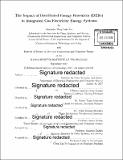The impact of distributed energy resources (DERs) in integrated gas-electricity energy systems
Author(s)
Yee, Alexander Wing Lake
DownloadFull printable version (7.052Mb)
Alternative title
Impact of DERs in integrated gas-electricity energy systems
Other Contributors
Technology and Policy Program.
Advisor
Ignacío Perez-Arriaga and Karen Tapia-Ahumada.
Terms of use
Metadata
Show full item recordAbstract
Our gas and power energy systems are interconnected, which makes the decision to provide energy a non-trivial one for consumers and the system as a whole. The focus of this thesis is on the long-term planning of integrated electricity and natural gas infrastructures at the distribution (low voltage) level. This research explores the question on how pricing relates to the coupling of a gas-electricity system given an expected greater consumer participation at the residential level. I developed a long-term planning tool that is able to consider the interaction between the integrated natural gas-electric energy system. In the first component of the tool, I formulated a mixed integer linear program, Z-DRE, as a proxy for the rational consumer. Given commodity prices, investment costs and demand profiles, Z-DRE would decide which distributed energy resource (DER) equipment or conventional equipment to invest in as well as when to run these equipment to meet its demand. The results of this program would determine what demand profile (or supply profile) the electrical and natural gas grids would need to meet. A model electrical grid and a model natural gas grid were simulated with these demands in order to determine if any reinforcement was needed. If reinforcements were needed, a heuristic was used to determine where the reinforcement should be placed in the grid and iteratively continued this process until a 99% reliability was achieved. I considered two pricing incentives to determine what effect pricing could have on the individual consumer and the spillover effects to the overall grid. The two pricing strategies was (1) a static feed-in-tariff combined with a static residential consumption tariff and (2) a dynamic feed-in-tariff and a dynamic residential consumption rate, both pegged to the market rate of electricity. In the context of New England, I found that adoption of Combined Heat and Power (CHP) units was unlikely to occur without generous electricity feed-in-tariffs which would require a wealth transfer. As a result, it is anticipated that the integrated gas-electric network to be only loosely coupled for New England at the distribution level. I also considered what effect using prices that tracked the wholesale rate of electricity might have on CHP adoption and came to the similar conclusion that the electricity prices in New England are too low to spur CHP investment. I note that over-adoption of CHP units from extremely high feed-in-tariffs (in the cases of both the static feed-in-tariff and the dynamic feed-in-tariffs) caused an extraordinary need for electricity grid reinforcement in order to accommodate the enormous backward power flow back into the high voltage grid. However, the grid also needed moderate reinforcements when there was a low or no feed-in-tariff. I found the reinforcement cost minimum (and total cost minimum) can be found with a tariff that encourages only a portion of the population to purchase CHPs since the locally generated power could now be consumed within the distribution network. This lowered the need for capacity between the primary feeders of the high voltage network and the secondary distribution network.
Description
Thesis: S.M. in Technology and Policy, Massachusetts Institute of Technology, School of Engineering, Institute for Data, Systems, and Society, Technology and Policy Program, 2017. Thesis: S.M., Massachusetts Institute of Technology, Department of Electrical Engineering and Computer Science, 2017. Cataloged from PDF version of thesis. Includes bibliographical references (pages 99-102).
Date issued
2017Department
Massachusetts Institute of Technology. Department of Electrical Engineering and Computer Science; Massachusetts Institute of Technology. Engineering Systems Division; Massachusetts Institute of Technology. Institute for Data, Systems, and Society; Technology and Policy ProgramPublisher
Massachusetts Institute of Technology
Keywords
Institute for Data, Systems, and Society., Electrical Engineering and Computer Science., Engineering Systems Division., Technology and Policy Program.